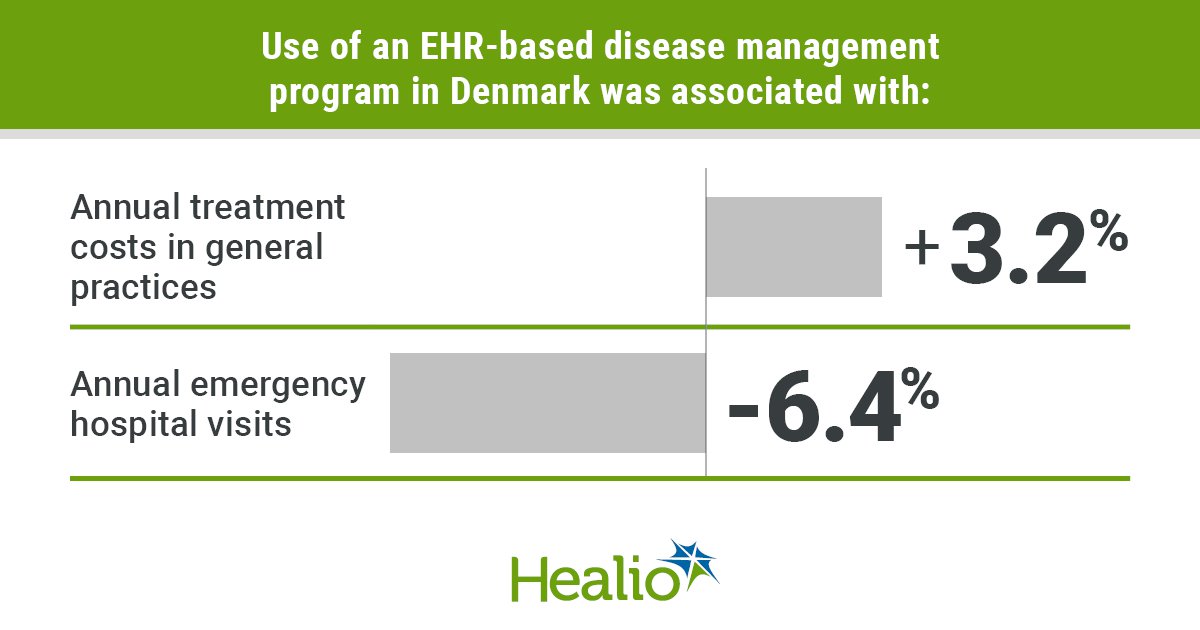Health care efficiency rises with EHR-based diabetes management model in Denmark
Use of an electronic health record system with a built-in diabetes management module was associated with a small increase in treatment costs for general practices and reduced demand for emergency hospital visits, researchers reported.
“Within a national public health care system, Danish general practitioners’ use of an electronic health record-based disease management program for patients with type 2 diabetes was not associated with any increase in total health care costs,” Ryan Pulleyblank, MSc, MA, a doctoral research fellow at the Danish Centre for Health Economics, department of public health, University of Southern Denmark, told Healio. “In combination with evidence of an associated reduction of demand for emergency hospital visits, this evidence supports the view that use of EHR-based disease management programs can lead to health care quality benefits for people with type 2 diabetes and health care system efficiency improvements.”
Pulleyblank and colleagues analyzed data from 33,970 adults with type 2 diabetes in Denmark who attended 244 general practices that used an EHR or a disease management program at a high level (50.2% men; mean age, 60 years) and 18,017 adults with type 2 diabetes who attended 344 general practices that never used the disease management system (controls; 51.6% men; mean age, 60 years), all treated between 2008 and 2014. An EHR/disease management program system was rolled out across general practices in Denmark beginning in 2011 and was discontinued in 2014; high level of use was defined as a median annual rate of coding 70% of patient visits.
“The diabetes module included tracking of health measures, including HbA1c levels, blood pressure, body mass index, cholesterol level and albuminuria, with color-coded indicators to highlight where patients were missing targets,” the researchers wrote in the study, published in JAMA Network Open. “In addition, the system enabled general practitioners to observe their performance compared with peers across local, regional and national levels.”

Main outcome was total health care costs; secondary outcomes were primary care, medication, nonhospital specialist and hospital costs. Researchers used regression analysis to estimate EHR/disease management program-associated percentage differences in annual health care treatment costs across health care treatment categories. All models included general practice-level fixed effects and patient-level controls. Two-part models examined robustness of estimated associations for hospital cost categories.
Researchers found no association between use of an EHR-based disease management program and changes in annual total hospital costs and total health care costs; however, there was a positive association between use of an EHR-based disease management program and annual treatment costs in general practice (3.2%; 95% CI, 0.9-5.6) and a negative association with annual emergency hospital visit costs (–6.4%; 95% CI, –11.6 to –1.2).

“The finding of a negative association between EHR-based disease management program use and mean annual emergency hospital costs but no association with differences in total hospital costs suggests that hospital visits were more likely to have been planned rather than emergency,” the researchers wrote. “That is, using the EHR-based disease management program may have been associated with general practitioners more effectively referring patients with diabetes to the hospital as appropriate. This can be interpreted as an improvement in process quality for patients attending these general practices.”
The researchers noted that “stronger evidence” of benefit may have emerged if the EHR-based disease management program were not discontinued after 3 years, adding that emergency visits and inpatient hospitalizations are expensive but relatively infrequent.
“Improvements to general practitioner’s synthesis and processing of type 2 diabetes patients’ health information can improve health care quality for patients,” Pulleyblank said. “This can occur through the facilitation of additional primary care to identified, underserved patients — subsequently avoiding demand for expensive emergency hospital-based care.”
Pulleyblank said researchers must identify the most clinically important information gaps between health care providers and how such gaps could be narrowed to improve health care quality without increasing costs.
For more information:
Ryan Pulleyblank, MSc, MA, can be reached at rpulleyblank@health.sdu.dk.
